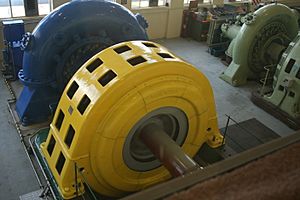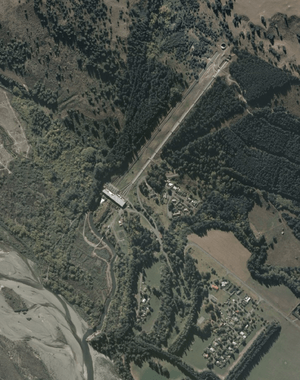Coleridge Power Station facts for kids
Quick facts for kids Coleridge Power Station |
|
|---|---|

Horizontal turbine (BTH) at Lake Coleridge power station
|
|
| Country | New Zealand |
| Location | Canterbury |
| Coordinates | 43°21′51″S 171°31′37″E / 43.36417°S 171.52694°E |
| Status | Operational |
| Construction began | 1911 |
| Owner(s) | TrustPower |
| Reservoir | |
| Creates | Lake Coleridge |
| Power station | |
| Commission date | 1914 |
| Type | Conventional |
| Turbines | 3 (1914), 9 (1930), 5 (today) |
| Installed capacity | 39 MW (52,000 hp) 4.5 MW (6,000 hp) (1914) 34.5 MW (46,300 hp) (1930) |
| Annual generation | 270 gigawatt-hours (970 TJ) |
The Coleridge Power Station is a special kind of power plant in New Zealand. It uses the power of water to make electricity. This plant is located at Lake Coleridge in the Canterbury area. It is owned and run by a company called TrustPower.
Contents
History of the Power Station
The Coleridge Power Station was very important for New Zealand. It was the first big power plant built with the government's help. Construction started in 1911. By 1914, it was finished with three machines that made electricity. Its main job was to send power to the city of Christchurch.
Most of the power station was built by hand. Some heavier jobs used machines called steam shovels. When it first opened, the power lines from Coleridge to Christchurch were special. They carried the highest voltage in New Zealand. They were also the longest, stretching over 100 kilometres (62 mi).
Growing Demand for Electricity
In the early years, people in Christchurch needed more and more electricity. The power lines reached new towns like Rangiora in the north. They also went south to Oamaru. Because so many people needed power, Coleridge sometimes could not make enough. This caused power outages.
To fix this, more generators were added. A fourth one started in 1917. Two more were added in 1921 and 1922. In 1924, the building where the machines were kept was made bigger. This allowed for even larger machines. By the early 1930s, Coleridge was making as much power as it could. Other power plants were built to help, like the Waitaki Dam in 1934.
Getting More Water
The power station needs a lot of water to work. So, engineers changed the path of three rivers to send more water into Lake Coleridge. The Harper River was diverted in 1922. The Acheron River was diverted in 1930. Much later, the Wilberforce River was diverted in 1977. This made sure the lake had enough water for the power plant.
Who Owned Coleridge?
The New Zealand Government first built and owned the power station. Over the years, the way the government handled electricity changed. In 1987, the government created a new company called the Electricity Corporation of New Zealand (Electricorp). This company took over running the power plants.
Electricorp started to make the power station more modern. They also reduced the number of staff. In 1992, Electricorp split into two parts. One part, Transpower, took care of the outdoor electrical equipment. The main company decided to sell the Coleridge plant.
In 1998, two companies, Alpine Energy and Trustpower, bought the power station for $90.6 million. Alpine Energy was only involved for a short time. Since then, Trustpower has owned and operated the Coleridge Power Station.
How the Power Station Works
The Coleridge Power Station is special because it does not use a big dam like most other hydroelectric plants. Lake Coleridge is a natural lake. It sits much higher than the power station building.
Water flows from the lake to the power station through two inlets. On calm days, you can see the newer No. 1 inlet as a whirlpool in the lake. These inlets feed water into two long tunnels. These tunnels go almost flat through about 2.2 kilometres (1.4 mi) of the hill.
The tunnels end in large concrete "surge chambers" above the power station. These chambers connect to special steel pipes called penstocks. These pipes run down the hill to the building where the turbines are. The older surge chamber is 12 metres (39 ft) wide. It connects to two large pipes, each 1.32 metres (4 ft 4 in) wide. The newer surge chamber is 19 metres (62 ft) wide. It connects to three more pipes. These pipes get narrower as they go down the hill.
The water rushes down these pipes, turning the turbines. After the water has been used, it flows out into the Rakaia River.
Power Output and Turbines
As of 2020, the Coleridge Power Station can make 39 megawatts (52,000 hp) of electricity. On average, it produces 270 gigawatt-hours (970 TJ) of electricity each year.
The station started with 3 turbines. By 1930, it had 9 turbines. These could produce 34.5 megawatts (46,300 hp) of power. Today, only 5 turbines are working. But even with fewer turbines, they make more energy than before. This is because they were updated and improved in 2008.
Coleridge was the first power station in the world to use "aerated draft tubes." These were invented right there at the station. They helped solve a problem with loud thumping noises when the machines were working hard. It was also the first power station built on glacial moraine. This is a type of ground left by glaciers. It caused some challenges for keeping the turbine building stable.
The power station also has an outdoor area with electrical equipment. This area sends 66kV power lines in two directions. Some lines go east to Christchurch. Other lines go west across the Southern Alps to supply the West Coast of New Zealand.
Types of Turbines
All the turbines at Coleridge are a type called horizontal Francis turbines.
| Number | Date Started | Power (kW) | Status |
|---|---|---|---|
| 1 | 1930 | 7,500 kilowatts (10,100 hp) | Active |
| 2 | 1927 | 7,500 kilowatts (10,100 hp) | Active |
| 3 | 1926 | 7,500 kilowatts (10,100 hp) | Active |
| 4 | 1914 | 1,500 kilowatts (2,000 hp) | No longer used |
| 5 | 1914 | 1,500 kilowatts (2,000 hp) | No longer used |
| 6 | 1914 | 1,500 kilowatts (2,000 hp) | No longer used |
| 7 | 1917 | 1,500 kilowatts (2,000 hp) | No longer used |
| 8 | 1921 | 3,000 kilowatts (4,000 hp) | Active |
| 9 | 1923 | 3,000 kilowatts (4,000 hp) | Active |


